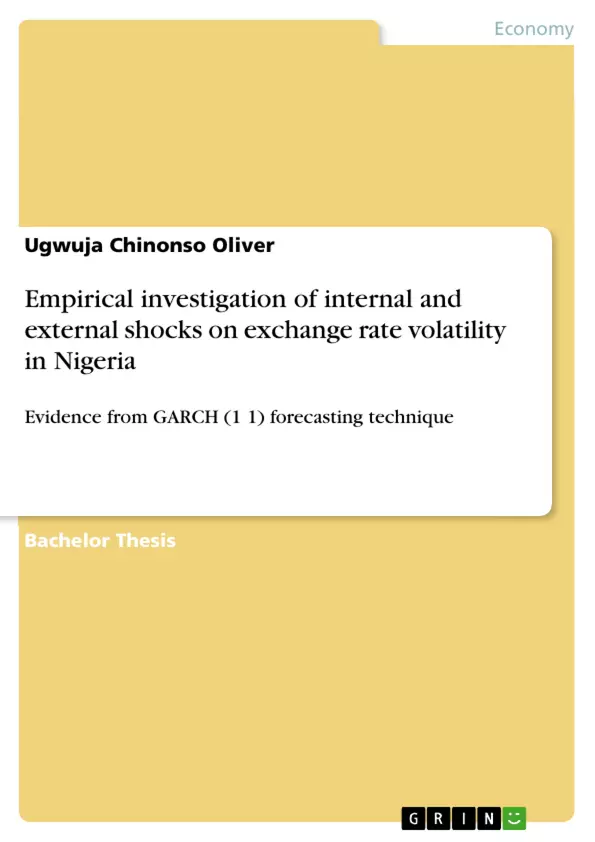The embracement of the International monetary funds’ (IMF) structural adjustment programme (SAP) in 1986 brought the Bretton-Woods system which marked a period of the largest experiment of the pegged exchange rate regimes in the post-World War II era to its knees. Ever since then, there has been a recoded high degree of volatility in the exchange rate of the naira vis-à-vis the US dollars.
In this regard, this study seeks to examine other sources of shocks to the exchange rate fluctuations in Nigeria relying on time series data covering the periods 1986-2015. To execute this effectively, the Generalized Autoregressive Conditional Heteroscedasticity (GARCH) model introduced by Tim Bollerslev (1986) was used to decompose these shocks into internal and external sources. Also, the time series properties of the data used were explored and the stationarity conditions of the chosen variables were examined by the help of ADF unit root test under three different test regression equations.
However, the GARCH (1 1) volatility forecasting result reveals that volatility shock is present and persistent and concludes that the fluctuations in the Real exchange rate of the naira is responsive to both domestic and international shocks. Consequently, this study recommends that policies be adopted to tame the degree of volatility in exchange rate because of the deleterious effect it could have on foreign transactions. Furthermore, to make the work more enticing and attractive to the readers, we sectionalized this study into Chapters; chapter one for introduction, chapter two for literature review, chapter three for Research methodology, chapter four for the presentation and analysis of empirical findings and chapter five.
Inhaltsverzeichnis (Table of Contents)
- Chapter One: Introduction
- 1.1 Background of the Study
- 1.2 Statement of the Problem
- 1.3 Objectives of the Study
- 1.4 Research Questions
- 1.5 Scope of the Study
- 1.6 Significance of the Study
- 1.7 Limitations of the Study
- 1.8 Organization of the Study
- Chapter Two: Literature Review
- 2.1 Theoretical Framework
- 2.2 Empirical Literature Review
- Chapter Three: Research Methodology
- 3.1 Model Specification
- 3.2 Data and Sources
- 3.3 Data Analysis
- 3.4 Model Estimation
- Chapter Four: Presentation and Analysis of Empirical Findings
- 4.1 Data Description and Analysis
- 4.2 Model Estimation and Results
- 4.3 Discussions of Findings
- Chapter Five: Summary, Policy Implications, Conclusions and Recommendations
Zielsetzung und Themenschwerpunkte (Objectives and Key Themes)
This research investigates the impact of both internal and external shocks on exchange rate volatility in Nigeria, using the GARCH (1 1) volatility forecasting technique. The study aims to identify the sources of these shocks and assess their contribution to exchange rate fluctuations. Key themes explored include:- Exchange rate volatility in Nigeria
- Internal and external shocks to the exchange rate
- The GARCH (1 1) model and its application in volatility forecasting
- Policy implications for managing exchange rate volatility
Zusammenfassung der Kapitel (Chapter Summaries)
Chapter One: Introduction
This chapter sets the stage for the research by introducing the background, problem statement, objectives, research questions, scope, significance, limitations, and organization of the study.Chapter Two: Literature Review
This chapter delves into the theoretical framework and empirical literature related to exchange rate volatility. It examines existing models and studies that have investigated the impact of internal and external shocks on exchange rate fluctuations.Chapter Three: Research Methodology
This chapter outlines the methodology used in the study, including the model specification, data sources, data analysis, and model estimation techniques. It focuses on the GARCH (1 1) model and its application in volatility forecasting.Chapter Four: Presentation and Analysis of Empirical Findings
This chapter presents and analyzes the empirical findings of the study, including data description, model estimation results, and discussions of the findings.Schlüsselwörter (Keywords)
The study focuses on key concepts like exchange rate volatility, internal and external shocks, the GARCH (1 1) model, volatility forecasting, and policy implications for managing exchange rate fluctuations in Nigeria.- Arbeit zitieren
- Ugwuja Chinonso Oliver (Autor:in), 2017, Empirical investigation of internal and external shocks on exchange rate volatility in Nigeria, München, GRIN Verlag, https://www.grin.com/document/457704



